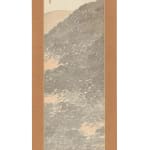Hirai Baisen
Mountain Landscape, 1911
Hanging scroll; ink and colors on paper
Overall size 81 x 17 in. (206 x 43 cm)
Image size 52¼ x 12¼ in. (133.3 x 30.5 cm)
Image size 52¼ x 12¼ in. (133.3 x 30.5 cm)
T-3677
Further images
Signed at top left: Painted by Baisen in the summer of 1911, with seal Baisen Huddled at the edge of a snowfield, the houses of a Japanese village seem almost...
Signed at top left: Painted by Baisen in the summer of 1911, with seal Baisen
Huddled at the edge of a snowfield, the houses of a Japanese village seem almost overwhelmed by a giant, tree-clad mountain that rises steeply up behind them; a further barren slope in the far background emphasizes the rugged remoteness of the scene. The almost abstract treatment of the contrasting textures of snow and forest is unusually daring for a painting executed in the closing years of the Meiji era and reflects the experimental spirit that prevailed in painting circles in Kyoto under the leadership of pioneering master painters such as Takeuchi Seihō (1864–1942).
This hanging scroll is a rare early instance of the landscape style of Hirai Baisen, a Kyoto painter who graduated from the city’s Municipal Art and Craft School in 1906 and in the following year, aged only nineteen, participated in the very first Bunten national exhibition in Tokyo, where he showed an atmospheric painting entitled Kyūen no asa (Morning in the Imperial Garden). The versatile and precocious young man also submitted an ambitious narrative handscroll depicting the downfall of the Taira clan to the Japan-British Exhibition held in London in 1910 and would continue to participate in the Bunten and its successor exhibitions almost every single year until 1942. In addition, he seems to have been an indefatigable mover and shaker on the Kyoto cultural scene, taking part in the formation of artistic groups such as Tōkakai (Peach Flower Association, 1910) and the Batosaya (1911), a group of intellectuals from the literature department of Kyoto University.
Huddled at the edge of a snowfield, the houses of a Japanese village seem almost overwhelmed by a giant, tree-clad mountain that rises steeply up behind them; a further barren slope in the far background emphasizes the rugged remoteness of the scene. The almost abstract treatment of the contrasting textures of snow and forest is unusually daring for a painting executed in the closing years of the Meiji era and reflects the experimental spirit that prevailed in painting circles in Kyoto under the leadership of pioneering master painters such as Takeuchi Seihō (1864–1942).
This hanging scroll is a rare early instance of the landscape style of Hirai Baisen, a Kyoto painter who graduated from the city’s Municipal Art and Craft School in 1906 and in the following year, aged only nineteen, participated in the very first Bunten national exhibition in Tokyo, where he showed an atmospheric painting entitled Kyūen no asa (Morning in the Imperial Garden). The versatile and precocious young man also submitted an ambitious narrative handscroll depicting the downfall of the Taira clan to the Japan-British Exhibition held in London in 1910 and would continue to participate in the Bunten and its successor exhibitions almost every single year until 1942. In addition, he seems to have been an indefatigable mover and shaker on the Kyoto cultural scene, taking part in the formation of artistic groups such as Tōkakai (Peach Flower Association, 1910) and the Batosaya (1911), a group of intellectuals from the literature department of Kyoto University.
Exhibitions
Basel Design 2019













